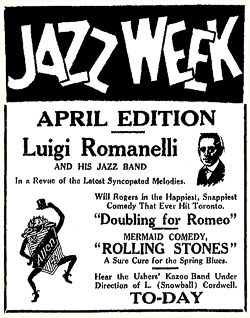
|
|
The notice for the second edition of Jazz Week at the Allen Theatre. The first advertisement for “Jazz Week at the Allen” did not mention Luigi and his band but three days later the first review credited Luigi Romanelli and his famous Jazz Band
with attracting full houses at each performance in “Toronto’s first introduction to ‘Jazz Week’....and from the hilarity, the city’s devotees of syncopation like it”
(TDS, Mar. 20, 1922, p. 19)
|
|
|
Luigi Romanelli: Monarch of Melody
Part II
© Arthur E. Zimmerman and Betty Minaker Pratt
Luigi Becomes “Old King Jazz”
Suddenly, adapting to changing times, the Allen featured “Luigi Romanelli and his Jazz Orchestra” (TDS, Dec. 23, 1921, p. 19), though the King Eddie continued to advertise his “famous concert orchestra during the dinner hours” (TDS, Dec. 30, 1921, p. 21). The first Jazz Week at the Allen featured “Luigi Romanelli and his Jazz Band....a real Jazz cast” in the film “From the Ground Up” and drew full houses of the city’s devotees of syncopation and hilarity (TDS, March 20, 1922, p. 19). Romanelli’s very mild jazz likely included a great deal of novelty - horse-braying trumpet, squeaking clarinet and percussion effects -
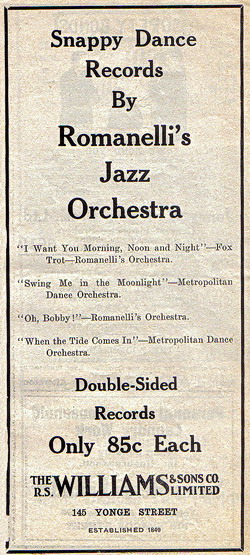
|
|
R.S. Williams advertisement in a Royal Alexandra Theatre program for the week of April 24, 1922, promoting two Berliner-HMV sides by Romanelli’s Jazz Orchestra, Allen Theatre. In November 1924, Luigi and his celebrated Royal
Alexandra Theatre Orchestra gave a program at that theatre every evening during the run of the play “Cheaper to Marry”.
(from the collection of Betty Minaker Pratt)
|
|
|
“As stimulating as an attack of prickly heat. Something doing every minute.....Fun, frolic and amusement for all” (TDS, March 17, 1922, p. 24), “It’s Hot!”
and “Luigi Romanelli and his Jazz Musikers jazzing like six hundred” (TDS, April 13, 1922, p. 13).
The Allen boasted that “Last night was the limit! Five people almost fainted from laughter! To prevent this, attendants now mingle with the audience, squirting water
on the faces of those unable to control themselves. No extra charge for this service. We provide the life savers!” (TDS, March 22, 1922, p. 21). The Allen Premier Concert Orchestra also showed “what operatic overtures are like when jazzed” and Luigi introduced
a popular novelty, leading an audience chorus of 1,500 (TDS, March 23, 1922, p. 22).
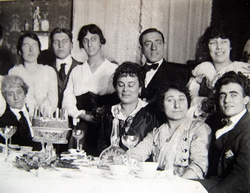
|
|
Another family photo, taken at a birthday party, circa 1915. Selina is seated at centre, with Luigi standing behind her. Enrico (Henry) del Greco is seated at lower right, next to future wife, Lucy Romanelli.
(courtesy Dante del Greco)
|
|
|
Right after the first “Jazz Week” at the Allen, Romanelli’s Orchestra (his Jazz Musikers) was invited to participate in The Toronto Star’s first radio-telephone concert, aired over the Canadian Independent Telephone Company’s station 9AH from the new Canadian
General Electric factory at Ward Street and Wallace Avenue on March 28 (TDS, March 27, 1922, p.1; March 29, 1922, p. 1). They aired “a popular medley of the latest hits in syncopated harmony..... ‘The Sheik’, ‘Oh Me Oh My’, ‘Sweet Hortense’ (when the sax
player sang a few verses into the receiver - Les Allen?), the ‘Wabash Blues’, ‘Say It with Music’, ‘If Winter Comes’ and ‘The Moonlight Serenade’......Toes twitched to the dancing lilt in them. Then the hanging ha-ha of the sobbing saxophone, the sweet trills of the piccolo.....and at times the warm crashing of the massed ensemble”. Luigi told The Star that it was quite a sensation to fill Central Ontario with jazz, and observed that jazz was spreading (TDS, March 29, 1922, p. 1; APN, Jan.-Feb. 2001, p. 8), though what he
played was novelty syncopated pop and not really jazz.
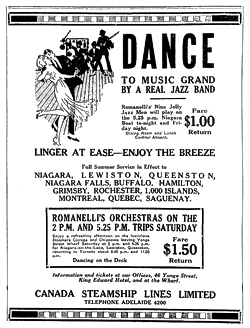
|
|
For $1.00 apiece, one could dance to Romanelli’s Nine Jolly Jazz Men aboard the Niagara Boat, on the Thursday or Friday night return trip to Niagara-on-the–Lake, and for $1.50 on the deck of the luxurious Cayuga and Chippewa from 2:00 and 5:25 p.m.
Saturdays
(TDS, Aug. 17, 1922, p. 2)
|
|
|
Romanelli’s jazz was akin to Paul Whiteman’s, who said that he led a modern American orchestra and not a jazz band. Whiteman said, “One of the things we try to do on our programs is to show the difference between what most people call jazz and what we
regard as the legitimate use of the jazz element in modern American music. Early jazz was just five perfectly good instruments in rotten company: cornet, clarinet, saxophone, piano and drum; and you know what a frightful noise they could make and the
contortions they created. Well, we took those and a few more, along with a few of what may be called freak instruments, and evolved the modern American orchestra. Early jazz and jazz for years afterwards depended mainly on the players’ ability to fake in
different effects in rhythm and tone colour and accent. We don’t use the fake method at all. Our music is all scored” (TDS, May 30, 1924, pt. 2, p. 1).
In 1922 (TDS, July 18, 1922, p. 3), Romanelli’s jolly jazzers, his 9 Merry Melody Men, began supplying music for dancing on the deck of a Canada Steamship Lines (CSL) Niagara-bound boat, with dining room, lunch counter and soda fountain on board.
“Dance to Music Grand by a Real Jazz Band - Linger at Ease - Enjoy the Breeze”, Yonge Street Wharf, 5.25 p.m., $1.00 return. There were also 2 p.m. Wednesday and Saturday sailings on the Cayuga with Romanelli’s Orchestra and soon after 2 p.m.
and 5:25 p.m. dance trips on Saturdays aboard the Cayuga and Chippewa, $1.50 return (TDS, Aug. 17, 1922, p. 2). These Romanelli Orchestra dancing excursions continued every summer until at least 1927, when Don was music director for CSL
(ET, Aug. 6, 1927, p. 7) and they played on the Chippewa every weeknight. (TDS, July 22, 1927, p. 23). Brothers Don and Leo and brother-in-law Henry del Greco substituted for Luigi at times in the theatre, at the KEH and certainly on the Niagara-bound boats.
We found yet another Moonlight Sail with Romanelli’s Orchestra in 1935 (TDS, Aug. 31, 1935, p. 20).
Over the years, as well as the Niagara boat excursions, Luigi developed the business of booking Romanelli orchestras for private dances and parties, for weddings, radio broadcasts and commercial occasions.

|
|
|

|
I Want You Morning, Noon and Night (3:17)
HMV 216360-A
|

|
Oh! Bobby (We'll Be Happy In Our Little Home For Two) (3:05)
HMV 216361-B
(Listen for Luigi's violin at 1:20)
|
|
|
|
|
Romanelli and his Allen Theatre Orchestra also made his first two dance recordings for Herbert Berliner’s dark blue HMV label around March 1922 (JL). We found two record release announcements, 46 days apart (LA, April 15, 1922, p. 4; G, June 1, 1922, p. 15).
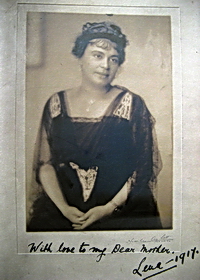
|
|
Selina Stanley (1875-1949) was born in St. George in the East, London, daughter of James and Lidia (nee Cripps) and eldest of six siblings. Selina Stanley first arrived in Canada in 1902, appears in the 1911 Canadian Census,
travelled extensively and independently on her inheritance, often as Selina Stanley Martin. Millie Romanelli, her friend, took her to her Italian club and then home to dinner with the Romanelli family. Lena and Luigi knew each other
ten years before they were married in 1922.
(courtesy BRS)
|
|
|

|
|
Selina Stanley’s House, 34 Henry Street, north-west corner
of Cecil Street, Toronto
|
|
|
Luigi left for Europe in July 1922 and, in St. Martin’s Parish, London, married Selina Stanley, a friend of sister Millie and ten years his senior, whom he had known in Toronto for many years. There had been both Church and Romanelli family resistance to his
marrying an Anglican, so they went overseas to marry in St. Martin’s Parish, London (Marriage Registrations, July-Sept., 1922, p. 309; Vol. 1a, p. 1404). They stayed at the Hotel Cecil, toured in France, Belgium and Italy and sailed back on September 23
to live in Selina’s house at 34 Henry Street (Declaration of Passenger to Canada, Form 30A; MCTD). Luigi brought back “a number of Europe’s terpsichorean novelties” to introduce into his KEH Orchestra’s afternoon tea dances (TSW, Sept. 15, 1923, p. 41).
Selina had a large influence on Luigi, polishing his dress and presentation and encouraging him to smile more. She had a wonderful ear and could offer useful musical advice - supper music at the KEH sounded better with a smaller band of ten. Several summers
she guided him around Europe and took him to the Folies Bergères, where Luigi was quite shocked (BRS).
Possibly one of Selina’s dignified touches to spice up his act was that Luigi would stride out waving a small silk handkerchief and then a little Chinese boy would appear carrying Luigi’s violin in a large piece of silk. A flourish of the handkerchief and Luigi would exchange
it for his violin (Arpin).
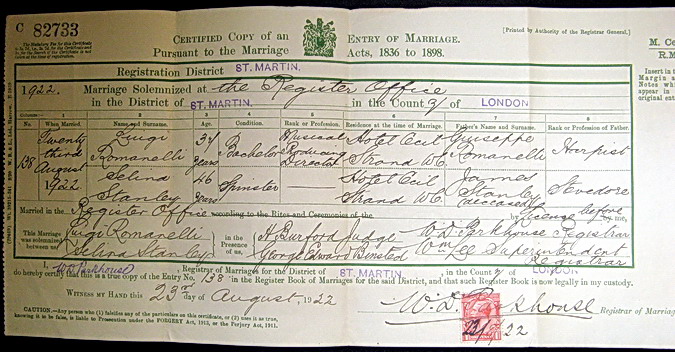
|
|
Marriage certificate of Luigi Romanelli, musical director and bachelor, age 34, and Selina Stanley, spinster, age 46,
in St. Martin’s Parish, London, England, August 23, 1922.
(courtesy BRS)
|
|
|
Irene Castle, popularizer with her late husband Vernon of the fox-trot, appeared in person at the Allen Theatre along with her latest photoplay, “Slim Shoulders”, in which she wore gorgeous clothes, drove a swift motorboat, rode horseback, danced, swam and
drove a fast car (TDS, March 12, 1923, p. 15). Luigi prepared a special accompaniment for the program, including music for her to show off fashions and to dance. Irene Castle so liked his playing of the big hit “Three O’clock in the Morning” and other waltzes
that she hired him to accompany her for the rest of her tour (TDS, Aug. 15, 1942, p. 22). We found no other independent supporting documentation of this story.
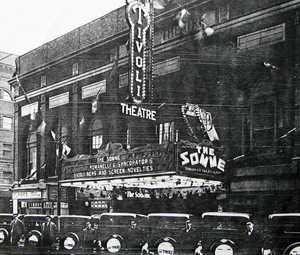
|
|
Tivoli Theatre, the former Allen Theatre, at Richmond and Victoria Streets, Toronto, mid-December, 1927
(courtesy Dante del Greco)
|
|
|
Things started looking bad for Luigi’s theatre job. The Allens came under attack from Toronto businessman N.L. Nathanson who, in alliance with Paramount Pictures, denied films to the Allens. After a winding-up order under the Bankruptcy Act, Nathanson,
now representing Famous Players Corp., offered to buy out the Allens (TDS, July 21, 1922, p. 10) and the transaction was concluded the next year (TDS, June 8, 1923, p. 19). Shortly afterward, Romanelli was appointed General Music Director for Canada
of the United Hotels Company of America, in charge of music for all of the hotels in the chain, and would be full time at the King Edward Hotel (TSW, Sept. 15, 1923, p. 41). He would also be introducing “original features” picked up in his tour that summer
of the pleasure resorts of France, Belgium and Italy. This new post necessitated dropping his theatre work and the Allen Theatres gave him a farewell banquet (TDS, Sept. 15, 1923, p. 27). Soon after, the Allen was re-dedicated as the Tivoli Theatre (TDS,
Oct. 29, 1923, p. 4) and, 18 months later, the Tivoli made the “most sensational announcement in Toronto theatrical history”, that “Canada’s greatest musical director” Romanelli and his famous KEH Orchestra would begin appearing twice daily at the theatre,
at 2:30 and 8:15 p.m. (TT).
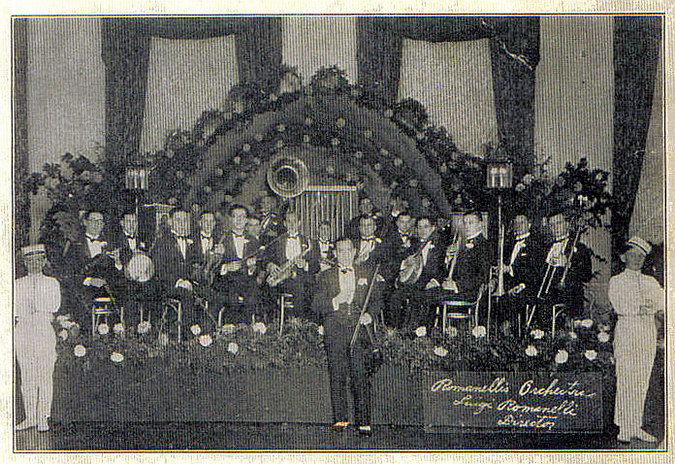
|
|
Luigi Romanelli, possibly holding his recently purchased $18,000 Guarnerius violin,
with his orchestra. Don Romanelli is third from left, with violin. Photographed in the
Crystal Ballroom, KEH, circa 1925
(courtesy Keith Miller)
|
|
|
The Romanelli Orchestra was one of the featured acts in the inaugural program of the Canadian National Railways radio network, over CFCA, The Toronto Star station (TDS, May 17, 1924, p. 9). The next year, Luigi bought two violins, an Amati and a Guarnerius,
left in Toronto by Philip Peltz, former director of music to the Tsar of Russia (TSW, June 13, 1925, p. 1; STTJ, Dec. 5, 1925, p. 20). The violins were in an alligator-skin case with gold mounts and on the back of the Guarnerius was a carved inscription indicating
that it had been made for Catherine the Great in 1728, and its authenticity had been certified by Hill of London. Obtaining a fine violin had been Luigi’s long-time dream, and now he had two.
Begins Playing for Royalty
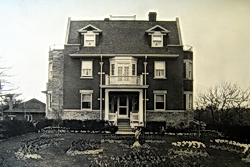
|
|
Luigi Romanelli’s new-built home at 2 Glenview Avenue, Lawrence Park, west off Yonge Street just south of Lawrence Avenue, circa 1927.
The house has been demolished.
(courtesy BRS)
|
|
|
A continuing connection with British royalty began when Luigi played for the Prince of Wales at Lt.-Col. F.B. Robins’ baronial “Strathrobyn” just outside of Toronto. This was the Prince’s fourth function and third dance party of the night and, some time before he
left around 6 a.m. (TDS, Oct. 16, 1924, p. 1), the Prince sat in with Luigi’s orchestra and played the drums (Fitch). The Prince said of the evening’s music, “It is the best I have yet heard” (TT). Luigi played for him the next year at the St. Thomas Golf and
Country Club (STTJ, Dec. 5, 1925, p. 20). Whenever the Prince of Wales passed through Toronto to visit his “E.P.” Alberta ranch, Romanelli provided music for the events (TDS, Jan. 28, 1931, p. 13), including the prince’s favourite tunes. One of these
was “When My Heart Stood Still” (TSW, Sept. 24, 1927, p. 55).
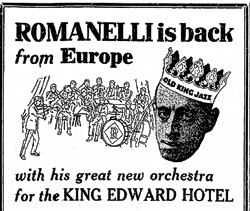
|
|
After Luigi and Selina returned from their 1927 European tour “with entrancing new orchestrations, gloriously lovely tonal effects, striking novelties”, Luigi organized a new orchestra of 12 master musicians for the KEH, “the smartest place in town”
and was hailed by the hotel as “Old King Jazz” for his “riotous, rollicking, foot-tingling jazz”
(G, Oct. 10. 1927, p. 19)
|
|
|
Luigi and his wife spent part of the summer of 1927 rambling through Europe, returning from Liverpool to Quebec aboard the S.S. Doric, September 2 - 10 (Ancestry.com). While they were away, the Prince of Wales
and his brother Prince George came to Toronto on tour and returned in late August to open the Princes’ Gates at the Canadian National Exhibition (CNE). It was brother Don who entertained the princes aboard the S.S. Cayuga between Lewiston and Toronto
(TDS, Aug. 6, 1927, p. 7) and likely Don who led Romanelli’s Orchestra at a dance in honour of the royals in the Crystal Ballroom of the King Edward Hotel. The crown prince requested his current favourite “At Sundown” and danced the “flat Charleston”
(TDS, Aug, 8, 1927, p. 20). Station CFCA, nevertheless, continued featuring “Luigi Romanelli and his Orchestra from the Tivoli”, on August 17 (TDS, Aug. 18, 1927, p. 8), with his Radio Syncopators in early September (TDS, Sept 1, p. 36; Sept. 2, p. 28;
Sept. 9, p. 28; Sept. 10, p. 8; Sept. 13, p. 3), and he and his King Edward Syncopators appeared with the film “Metropolis” at the Tivoli (TDS, Sept. 10, 1927, p. 8). When Luigi and Selina actually returned to Toronto, two trucks full of musicians playing
syncopated jazz accompanied them to their new house at 2 Glenview Avenue (TDS, Sept. 13, 1927, p. 10). He soon took up his baton at the Tivoli (TSW, Sept. 24, 1927, p. 55) and two weeks later the hotel announced the return of “Old King Jazz...with
his great new orchestra” (G, Oct. 10, 1927, p. 19). Romanelli later supplied the music for the reception of their imperial highnesses, the Prince and Princess Takamatsu of Japan, at Government House (TDS, May 7, 1931, p. 32) and for a state dinner for King
George VI and his queen at Niagara Falls in 1939 (TDS, June 8, 1939, p. 32). Later on at the Manoir Richelieu, he played “New Moon” at the request of the Duke of Kent (TDS, Sept. 2, 1941, p. 24).
A Frantic Pace

|
|
The announcement of a new series of
radio concerts by Luigi Romanelli conducting “The Hamilton By-Products Orchestra”
over station CKGW, the “Cheerio Station” with studios in the KEH, Toronto.
(TDS, Sept. 14, 1928, p. 30)
|
|
|
In 1928, Luigi began a series of Friday dinner-hour radio concerts for Hamilton By-Products Coke Ovens, Ltd., directing the Hamilton By-Products Orchestra over CKGW, the Gooderham and Worts “Cheerio” station (TDS, Sept. 14, 1928, p. 30 and Sept. 21,
1928, p. 37), with its office, room #9, and its studios in the KEH (TDS, Jan. 21, 1928, p. 16). Romanelli himself had an office with several secretaries and a manager to run his music business plus a huge music library, all on the second floor of the King Edward
Hotel (BRS; TLTP, p. 26).
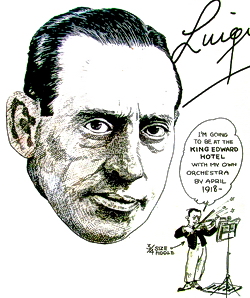
|
|
Skuce portrait of Luigi Romanelli, middle 1930s
(courtesy BRS)
|
|
|
Luigi and his several orchestras seemed to be working at a frantic pace: with a 24-piece stage band with Captain Plunkett’s “Dumbells-at-Home” revue at Victoria Theatre (TDS, Feb. 11, 1930, p. 13, and Feb.15, 1930, p. 8); beginning a weekly series of
broadcasts from the KEH through the Rogers Batteryless Station, CFRB, to the entire 45-station Columbia Broadcasting System (G, Sept. 27, 1930, p. 20); playing the formal opening of the Cadillac dealer, Bay & Grenville, over CKGW (TDS, March 20, 1931,
p. 24); appearing in General Motors’ all-star pageant “Canada on Parade” over CKGW, CKCL and 29 stations coast to coast for the “Forward Canada” and return to prosperity movement (TDS, Apr. 7,1931, p. 22 and Apr. 11, 1931, p. 2); and broadcasting
Tuesday midnights from CFRB to the Columbia Broadcasting System (TDS, June 2, 1931, p. 24). One night, his orchestra was switched remotely into a U.S.-wide broadcast of NBC’s “Dance Hour” from New York, with Coon-Sanders band and hosted by
Walter Winchell (TDS, March 2, 1932, p, 22). From that period, a 20-second silent clip of Romanelli conducting in the CFRB studio exists on a Rogers-Majestic industrial film (Batch). He directed a concert orchestra in the “Spring Revue of 1932” at Maple
Leaf Gardens, April 15, 1932, with Jean Harlow, Arthur Tracy and Stoopnagle and Budd, and at “The Spring Revue Frolic and Supper Dance” at KEH the night before, with all of the show’s stars (TDS, Apr. 14, 1932, p. 10). Romanelli’s “Monarchs of Melody”
may have appeared first over CKGW in late 1932 (TDS, Nov. 23, 1932, p. 24).
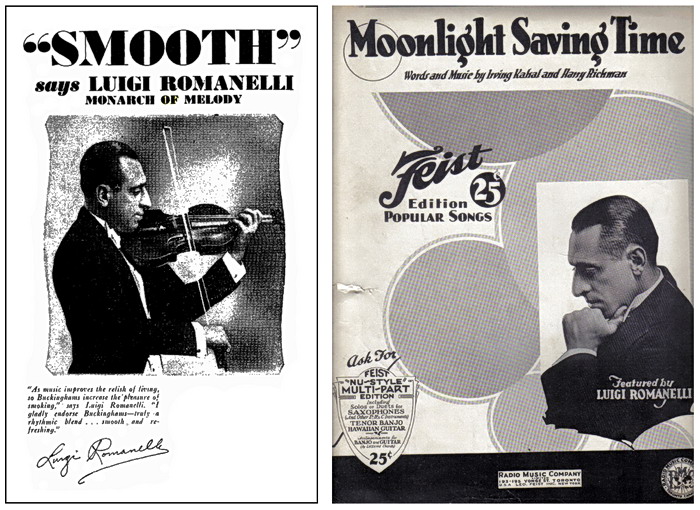
|
|
At left, Buckingham cigarettes tied its product to Luigi’s smooth style (TDS, Feb. 21/30, p. 10) and Feist’s 1931 hit, “(There Ought to Be a) Moonlight Saving Time” by Kahal and Richman, featured a 1924 portrait of a pensive
Luigi on its Canadian edition (sheet music from the collection of Betty Minaker Pratt).
|
|
|
Romanelli played for charity too: for the stranded French-Italian Opera Company in a Massey Hall benefit concert (TDS, Nov. 3, 1932, p. 7), for The Star Santa Claus Fund at Eaton Auditorium (TDS, Dec. 17, 1932, p. 24), for The Star Fresh Air Fund Broadcast
over CFRB (TDS, Aug. 11, 1934, p. 20) and at a KEH dance for the Scott Institute in support of the under-privileged (TDS, Feb. 13, 1935, p. 22).
Mr. L.P. Myers of Durie Street, winner of the all-Canadian radio poll, rated Romanelli’s Jimmy Davidson as the best crooner on Canadian radio and Luigi’s as the best dance orchestra, with Don’s and Leo’s orchestras not far behind (TDS, Feb. 11, 1933, p. 22).
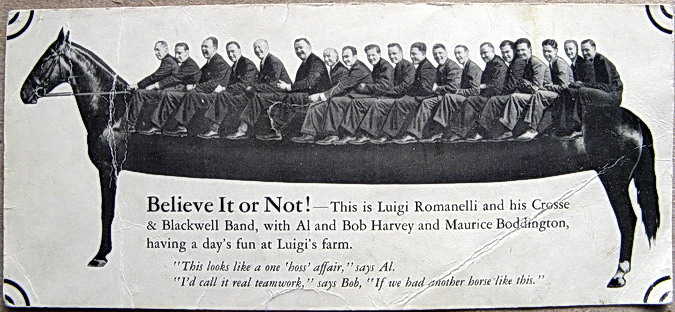
|
|
Luigi Romanelli, horse-man and -collector, with his Crosse and Blackwell Band, singer-comedians Al and Bob Harvey and radio personality Maurice Boddington, having fun on an enormous horse on Luigi’s farm. Crosse and Blackwell’s “Morning Night Club of the Air”
on CFRB was quickly moved from 8:00 a.m. to 6:30 p.m.
(TDS, Sept. 22, 1932, p. 22) (courtesy Dante del Greco)
|
|
|
In 1936, Luigi and the hotel announced the inauguration of “a new type of dance music that elevates jazz to the position it now occupies on the European continent....a distinctive 16-piece ensemble including a new string section of four violins....(and) the
engagement of Mr. Percy Faith internationally known arranger....” (TDS, Jan. 24, 1936, p. 8).
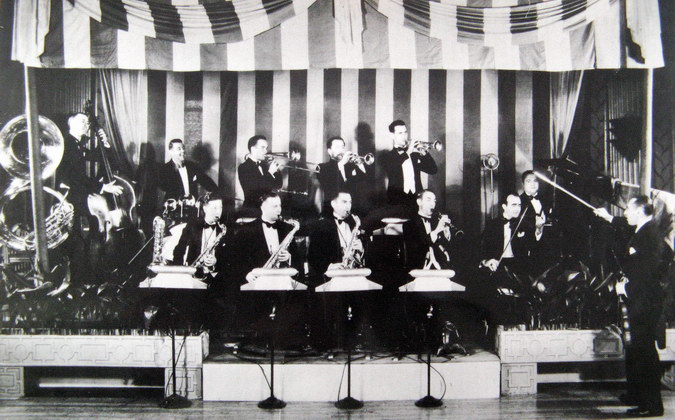
|
|
Luigi Romanelli and His King Edward Hotel Orchestra in the Crystal Ballroom, c. 1933
Back row, from left: Gurney Titmarsh (string bass & Sousaphone); Norm Eldridge, drums & traps; August Willgust, trombone; Ole Brandes,
first trumpet; Jimmy Davidson, 2nd trumpet and vocal; Jack Currie, piano. Front row, from left: Eddie Gelinas, baritone sax; Cub Murray,
tenor sax; Nat Cassells, 1st alto sax; Eddie Stroud, 3rd alto sax and vocal; Enrico del Greco, violin and assistant director; Luigi Romanelli,
directing with his violin bow (photo dated July 27, 1933)
(courtesy BRS)
|
|
|
He also made many commercial appearances over the years, for a Ryrie-Birks pre-Christmas social hour in the store (G, Nov. 22, 1924, p. 5); at Eaton’s College semi-annual furniture sales (G, Jan, 8, 1931, p. 18 and July 10, 1931, p. 20); in the formal
opening of the Cadillac showroom at Bay and Grenville (op. cit.) and even for society weddings (TDS, Apr. 29, 1938, p. 25) and private parties. “Trump” Davidson recalled, “When we played at the King Edward, we’d quit at 1:30 a.m., then go on to the
Hunt Club or a debutante dance and play for hours. To have Luigi appear with the band, they’d pay him $1,000” (BCDT, p. 4). Ellis McLintock told a story about the orchestra on stage in a white-tie auto show in Oshawa in late 1938. The roll-up curtain
caught Luigi’s tails and lifted him three feet into the air. Embarrassed by the helpless dangling and the uproarious laughter, Luigi ordered his men to pack up and leave (TLTP, p. 28).
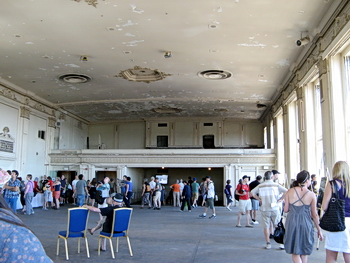
|
|
Appearance of the sumptuous Crystal Ballroom, atop the KEH, undergoing renovation during “Doors Open, Toronto” in the summer of 2009.
|
|
|
There were suggestions that Luigi and his orchestra were going to New York for an extended stay and a series of NBC broadcasts in 1936 (TDS, Dec.16, 1935, p. 22; ibid., Dec. 20, 1935, p. 30). We found no follow-through, except for a blurb that Luigi
was visiting Rudy Vallee in New York, and would be back the next week to take the baton from Leo and broadcast to the network again (TDS, Mar. 19, 1936, p. 26). After that, during almost all of the rest of 1936, we found no feature stories about Luigi
as musician and his radio broadcasts disappeared as well.
Luigi suffered a near-fatal heart attack some time in 1936. After a stay in St. Michael’s Hospital, he spent a year in bed at the King Edward Hotel while he recovered, but had another attack on the terrace at his Glenview Avenue house (BRS). We could
not document the affliction, but the Romanelli name re-appeared in the press only at the end of 1936 for the Christmas and New Year celebrations at KEH. “Toronto’s House of Hospitality” offered “inimitable Romanelli music”, but not Luigi (TDS, Dec. 15,
1936, p. 18; TDS, Dec. 29, 1936, p. 10). In early 1937, he and his orchestra played for the Toronto Granite Club “Coronation” Ice Carnival (a month after the abdication of Edward VIII, they were preparing for George VI’s coronation), first in Chicago,
where Ted Weems, George Olsen, Freddy Martin, “Red” Norvo and Mildred Bailey came to hear him (TDS, Jan. 26, 1937, p. 24) and then at Varsity Arena in Toronto (TDS, Jan. 28, 1937, p. 10). In Chicago, rather than standing, Luigi “conducted the
tempo of the music” sitting beside the organist (TDS, Jan. 13. 1937, p. 5). Perhaps it was at one of the ice show rehearsals that daughter Betty remembers Luigi’s chair sliding all over the ice (BRS).

|
|
“The Famous King Edward Hotel Orchestra under the direction of Luigi Romanelli who entertains in the Oak Room every evening, except Sunday, from 10 p.m.”, probably taken at Murray Bay, September 21, 1940.
In the orchestra were Dunc Snyder (drums), Leo Romanelli (violin, front left), Luigi Romanelli (front centre), Burt Austin (tall fellow in rear), Vince Boyd (piano), Cub Murray, Nate Cassells and Jimmy Empringham
(courtesy Dante del Greco)
|
|
|
There were whispers that Jimmy Davidson, Ole Brandes, Eddie Houston, Joe Niosi and Jack Neilson were leaving Romanelli’s band for a new troupe at the Esquire in Parkdale (G, Jan. 18, 1937, p. 8). In March, the KEH announced “Dancing to the smooth
rhythm of Luigi Romanelli’s New Band in the Famous Oak Room” (TDS, Mar. 17, 1937, p. 12) and in June “Luigi Romanelli and His Incomparable Music” on the KEH Summer Roof Garden (G, June 4, 1937, p. 12). It is not clear that Luigi himself was directing
until months later, “...After a long siege of illness, Luigi Romanelli will be back on deck to-night to lead his ‘Monarchs of Melody’...Tab CFRB’s 8:30 program for a listen to-night” (TDS, Aug. 27, 1937. P. 28).
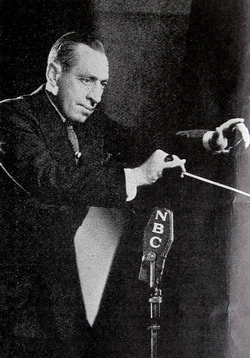
|
|
Stock photo used in Toronto Hotel Weekly, week of Sept. 12, 1937 (courtesy Dante del Greco) and later used in this announcement that Luigi Romanelli and his famous orchestra would be heard on the
NBC Blue Network from Hart House, beginning at 7:00 p.m. Friday, March 20, 1942, for 15 weeks. And also mentioned are four Bluebird sides just recorded for RCA Victor
(courtesy BRS)
|
|
|
During the royal visit in 1939, Romanelli and his orchestra played before King George and his Queen at a state dinner (TDS, June 8, 1939, p. 32) in the Rainbow Room, Gen. Brock Hotel, Niagara Falls (TDS July 29, 1942, p. 2). During a Scottish medley,
in which Luigi imitated bagpipes, he was astonished and almost dropped his violin when the Queen beat time on the table to “Annie Laurie”. Their Majesties were compelled to leave their ice cream to melt, crossing the border to meet Cordell Hull, U.S. Secretary
of State (TDS, July 29, 1942, p. 2), probably over the crisis in Europe.
Luigi was also interested in horses and we found him bringing in “Lochinvar” from Calgary to do stud duty at his farm in Markham (G, Dec. 15, 1936, p. 17).
“I became interested in horses through my cousin (Roxy).....(Question: Were race horses your favourite?) No, I like all horses. I like polo ponies, hunters and saddle horses. At one time they were all represented in my stable. In all, there were 98 horses.
I keep up the interest but I’ve cut down my number. I now have only 8 horses. I’m going in for antiques because I find that they don’t demand so much of my time” (Fitch).
Soon after, Luigi sailed with his wife, daughter and orchestra aboard the S.S. Kingston for a summer engagement at the Manoir Richelieu at Murray Bay (La Malbaie), Quebec (G, June 20, 1939, p. 11), and he returned there for his last three summers
(TDS, Feb. 3, 1940, p. 23). Swimming-to-music became a popular pastime at the outdoor concerts (G, Aug. 12, 1939, p. 12). There is a story of his horseback riding at Murray Bay, all properly attired in ascot, derby and breeches, of his being thrown
by his mount, getting up with dignity, remounting and riding away (TLTP, p. 24). Once, vocalist Burt Austin could not remember the lyrics to a song. “Forget the lyrics,” said Luigi. “Just sing the words” (Arpin).
Romanelli’s radio theme song had been “O Sole Mio”, but was immediately changed to Ernest Seitz’ “The World is Waiting for the Sunrise” after Italy entered WW II on the side of the Axis Powers, June 10, 1940. Years before, The Star’s radio editor had
suggested as Luigi’s theme, “No Matter Where I Romanelli, O’er Land or Sea or Foamanelli” (TDS, Oct. 18, 1934, p. 28). Luigi also did war work, appearing on the Toronto-based “Ned Sparks Show” for the CBS network (WSL, April 20, 1941, p. 16).
But he also collaborated in the composition of several patriotic songs for WW II, including the “Ode to Victory” and “There’s a Blackout in My Heart”.

|
|
Luigi Romanelli and his orchestra performing pool-side at the Manoir Richelieu, Murray Bay, circa 1939. That’s 10 year-old daughter Betty Romanelli in the water on the far side of the pool. Swimming to an hour of popular music
became a favourite pastime with patrons and, after a formal concert in the second hour, they went indoors for tea
(courtesy BRS)
|
|
|
References:
|
ALE
|
Ancestry, Library Edition, on-line - Ancestry.com
|
|
APN
|
Antique Phonograph News, Canadian Antique Phonograph Society, Toronto
|
|
Arpin
|
“John Arpin: Keyboard Virtuoso”, by Robert Popple (Natural Heritage Book, Dundurn Group, Toronto, 2009)
|
|
Barr
|
“The Almost Complete78 RPM Record Dating Guide” by Steven C. Barr (2nd edition, private publication, Toronto, 1979)
|
|
Batch
|
“Canada’s Finest”, Rogers-Majestic industrial silent film, c. 1932, courtesy Mike Batch of CAPS
|
|
BCDT
|
“The Bands Canadians Danced To” by Helen McNamara and Jack Lomas (Griffin House, Toronto, 1973)
|
|
Bray and Litchfield
|
“Label Types of Bluebird Records” by Colin J. Bray and Jack Litchfield, APN, Jan.-Feb. 1993, pp. 9-12
|
|
BRS
|
Betty (Romanelli) Sanford, personal communications, October 15, 2010 and April 13, 2011
|
|
Carnegie Hall
|
“An Evening with Groucho Marx” at Carnegie Hall, 1972; A&M Records SP 3515
|
|
CC
|
Census of Canada
|
|
CJM
|
Canadian Journal of Music (ed. by Luigi von Kunits), Vol. 4 #9, p.140, February 1918
|
|
Coulter
|
personal communication from June Coulter, Wheatley Area Historical Society, May-June 2008
|
|
CWM
|
letter from Erin Foley, Archivist, Circus World Museum, Baraboo, Wis., June 11, 2008
|
|
Dante del Greco
|
personal communication, November 3, 2007
|
|
ET
|
Evening Telegram, Toronto
|
|
EMC
|
Encyclopedia of Music in Canada, 2nd edition (ed. Kalmann & Potvin; University of Toronto Press, Toronto, 1992)
|
|
Fitch
|
Fitch Bandwagon, broadcast from Toronto for WEAF, New York, May 14, 1939
|
|
G
|
The Globe, Toronto
|
|
Goad
|
Goad’s Fire Maps, 1903; City of Toronto Archives
|
|
JL
|
personal communication from Jack Litchfield of CAPS
|
|
LA
|
London Advertiser, London, Ontario
|
|
LFP
|
London Free Press, London, Ontario
|
|
LRP
|
personal communication from Lisa Rae Philpott, Music Reference/Collections/ Instructional Librarian, Music Library, University of Western Ontario, London; 2008
|
|
Marks
|
“The Canadian Kings of Repertoire: The Story of the Marks Brothers” by Michael V. Taylor
|
|
MCTD
|
Might’s City of Toronto Directory
|
|
Moogk
|
“Roll Back the Years: History of Canadian Recorded Sound and its Legacy” by Edward B. Moogk (National Library of Canada, Ottawa, 1975, page 260)
|
|
Nabes
|
“The Nabes: Toronto’s Wonderful Neighborhood Movie Houses” by John Sebert (Mosaic Press, N.Y., 2001)
|
|
NYT
|
New York Times, New York, N.Y.
|
|
Pickford
|
“Sunshine and Shadow: An Autobiography” by Mary Pickford (Doubleday and Company, Garden City, N.Y., 1955)
|
|
Ringling Museum
|
letter from Jessie Christian, Tibbals Digital Collection Manager, The John and Mabel Ringling Museum of Art, June 16, 2008
|
|
RTD
|
Richmond Times-Dispatch, July 21, 1903, p. 4
|
|
Rust
|
“Jazz Records, 1897-1942” by Brian Rust (Storyville Publications and Company, London, 1969)
|
|
Shea's
|
advertisement in Shea’s Victoria Theatre program, week of November 10, 1919
|
|
Skuce
|
Presentation cartoon by Lou Skuce, possibly late 1930s, courtesy of Betty (Romanelli) Sanford
|
|
Solway
|
“Recollections of a Violinist” by Maurice Solway (Mosaic Press, Oakville, Ontario, 1984)
|
|
STTJ
|
St. Thomas Times Journal, St. Thomas, Ontario
|
|
TBH
|
“The Brothers Hambourg” by Eric Koch (Robin Brass, Toronto, 1997)
|
|
TDS
|
Toronto Daily Star
|
|
TDSBA
|
Toronto District School Board Archives, McCaul Street
|
|
TLTP
|
“They Loved to Play: Memories of the Golden Age in Toronto” by Murray Ginzberg (Eastend Books, Toronto, 1998)
|
|
TRL
|
Toronto Reference Library, Yonge Street, Toronto
|
|
TSR
|
program of “The Spring Review” at Maple Leaf Gardens, Toronto, April 15, 1932
|
|
TSunW
|
Toronto Sunday World
|
|
TSW
|
Toronto Star Weekly
|
|
TT
|
Tivoli Topics, Vol. 1, No. 1, page 1, Toronto, April 20, 1925
|
|
TW
|
Toronto World
|
|
USC
|
United States Census
|
|
V
|
Variety
|
|
Whitfield
|
“Pickford: The Woman Who Made Hollywood” by Eileen Whitfield (Macfarlane Walter & Ross, Toronto, 1997) and Eileen Whitfield, personal communication
|
|
WSJ
|
Wisconsin State Journal, Madison, Wisconsin, U.S.A.
|

|
|
A letter on Romanelli Orchestra letterhead, dated June 15, 1942, advising Lena how and where to catch the boat for Murray Bay.
Under the typed “Your loving husband”, it is signed “Luigi”.
(courtesy BRS)
|
|
|
Thanks to:
Mrs. Betty (Romanelli) Sanford; Dante del Greco; Joyce Romanelli; Joe Moore, Suffolk; Gerald Fabris, Museum Curator, Edison National Historic Site, West Orange, N.J.;
David Lennick, Jack Litchfeld, Mike Batch, Wayne Plunkett and Bill Pratt of CAPS; TDSB Achives; staff of the Baldwin Room, Toronto Reference Library; Eileen Whitfield;
Murray Ginzberg; Ringling Museum of Art; Circus World Museum; June Coulter of Wheatley, Ontario; Pat Temple of the Elgin County Branch of the Ontario Genealogical Society in St. Thomas;
Lisa Rae Philpott of the Music Library at University of Western Ontario; staff of Mount Hope Cemetery, Toronto; Toronto Symphony Archives; Brian Quinn of the Royal Conservatory of Music;
University of Toronto Music Library.
|
|